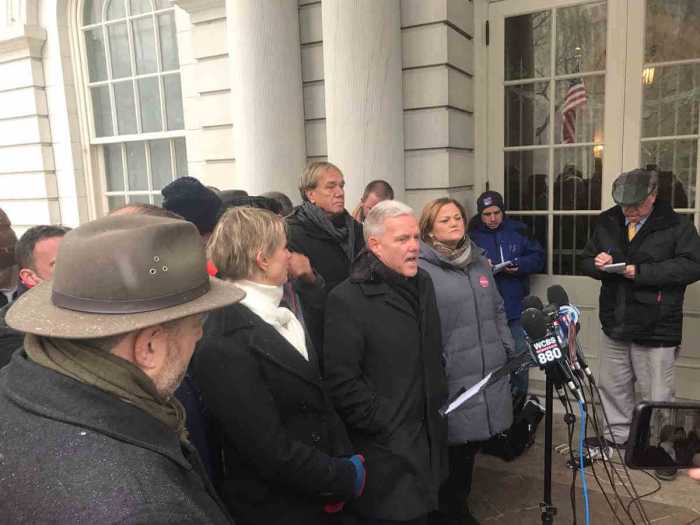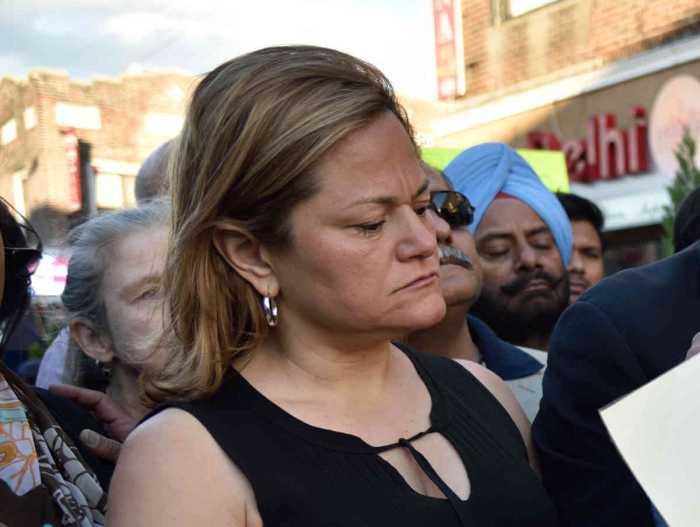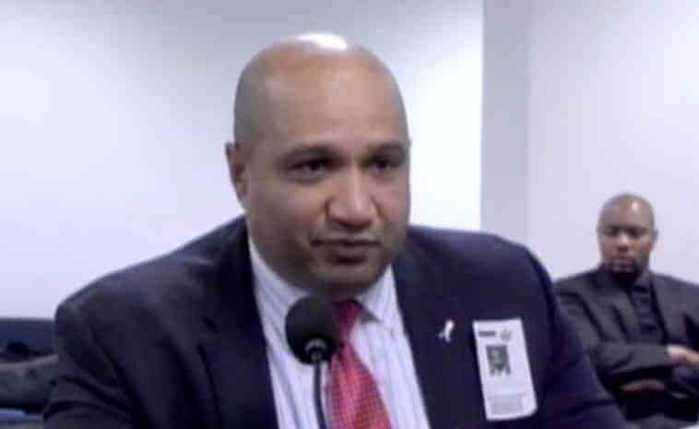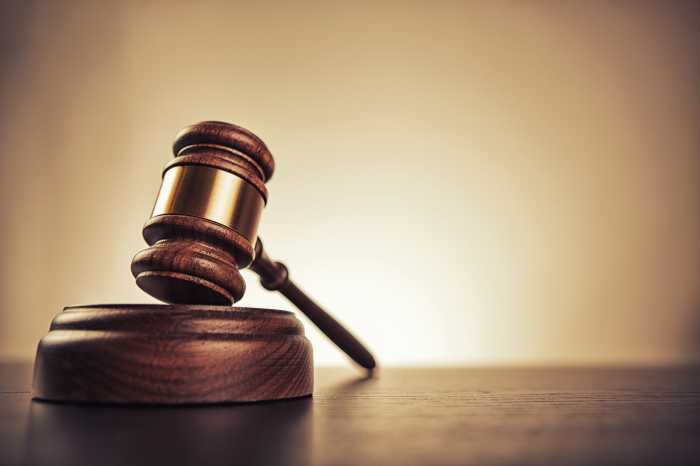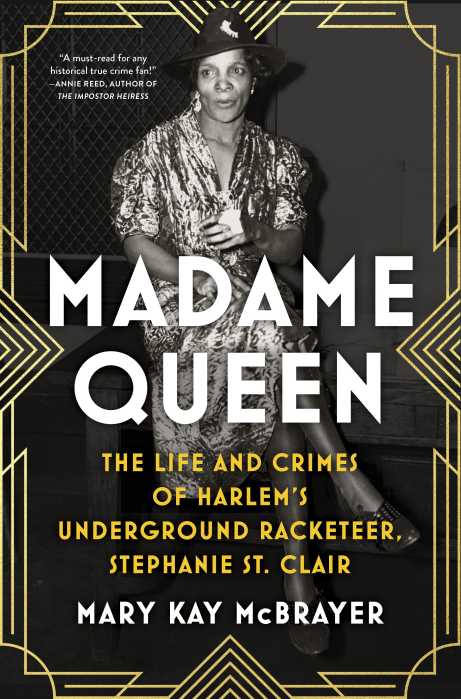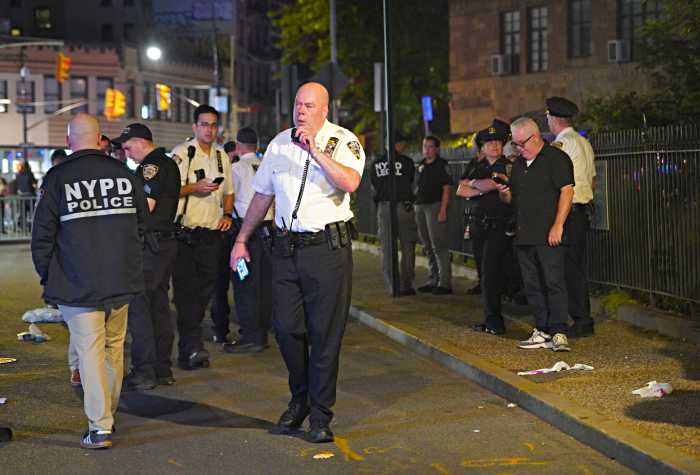Paul Kelterborn, Keith Fox, State Senator Brad Hoylman, and Chris Tepper at the December 1 dedication of the NYC AIDS Memorial Park. | DONNA ACETO
Sunny skies at the December 1 opening of the NYC AIDS Memorial Park in the West Village put the 18-foot steel canopy design on display like a bride or groom shown off at their best.
Located in the new St. Vincent’s Triangle Park that once housed utility equipment for the adjacent former hospital, the Memorial achieves with grace what its neighbor across West 12th Street –– originally designed for the National Maritime Union and now housing Lenox Hill Greenwich Village –– accomplishes with volume. A squat white building with no rectangular windows, only several bands of circular portholes, the Lenox Hill building delivers emergency medical services that are the last echo of what St. Vincent’s long provided to the neighborhood. Architecturally, it bears the same resemblance to the Memorial that a battleship has to a yacht –– imposing where the smaller craft is elegant.
The porthole motif of that building is picked up in the circular black marble water fountain that is the Memorial’s centerpiece. The water element is amplified in ever-widening circles on the gray granite floor inscribed with a text installation – made up of 10,000 words from Walt Whitman’s “Song of Myself” – designed by New York artist Jenny Holzer. The spiraling text reaches out toward the larger park, where chairs and tables foster passive recreation. With sharp baselines setting its boundaries, the Memorial has an apex with rounded shapes, topping the airy steel canopy composed of triangles. The Memorial is a landmark sculpture that in years to come will define the public perception of arriving in the heart of the West Village.
Walt Whitman's words inscribed in the gray granite floor of the Memorial. | DONNA ACETO
Keith Fox, the CEO of Phaidon Publishers who five years ago assumed responsibility for bringing the project to fruition, called it “the most beautiful and the most significant AIDS memorial” in the United States.
Mayor Bill de Blasio greets the dedication ceremony's host, Billy Porter. | DONNA ACETO
Fox, two urban planners, Chris Tepper and Paul Kelterborn, and government relations specialist Ethan Geto won warm shout-outs for their dogged efforts to realize their vision in a patch of urban redevelopment for which there were many competing ideas. The four deflected the praise, stressing the LGBT community’s enthusiasm as critical in winning the support of elected officials who helped fund the $6.5 million project.
Solidarity in the continued fight against the HIV epidemic was the consistent theme of the morning dedication, which was cohosted by the NYC AIDS Memorial Foundation and the End AIDS NY 2020 Coalition, uniting more than 50 advocacy and service organizations with the city and state health departments.
Board member Ethan Geto. | DONNA ACETO
Memorial co-founder Kelterborn, the planner who has typically been the silent partner in the project, spoke at the ceremony, offering an intimate explanation for his and Tepper’s motivation. Both gay men, who never knew a time without AIDS, were struck by the disconnect between their lives and generation and that of older gay men who lived through the plague that cost us more than 100,000 New Yorkers. They conceived of the memorial as a physical reminder to the young of what came before them as well as a refuge for those who recalled the pain they lived through.
Mayor Bill de Blasio, who at one point paused to collect himself as he evoked the suffering and death of friends, was one of many speakers who trumpeted the decline in new HIV infections. The 2,493 new cases identified in 2015, they emphasized, represent the lowest level on record. At the same time, the mayor warned against complacency, noting that 10 percent of the nearly 1.2 million Americans with living with HIV are in New York City.
“This Memorial will stand for a long time to keep our memories fresh,” de Blasio said.
Well over a thousand people gathered for the ceremony, and – as they inspected the new memorial, whose construction barriers had just come down overnight – many, like the mayor, remembered friends they lost but also the steeliness of activists who rushed forward during the worst days of the 1980s.
Housing Works' Charles King with Joey Pressley, deputy chief of staff to City Council Speaker Melissa Mark-Viverito. | DONNA ACETO
There was also a mood of celebration, as speaker after speaker emphasized the city and state’s commitment to end the epidemic over the next four years.
The mood shifted frequently, as well, to outrage, with jeers at every mention of President-elect Donald Trump.
Remarks by City Comptroller Scott Stringer – who while Manhattan borough president provided the project with its first $1 million in funding, enhancing its credibility – drew the most enthusiastic reaction from the crowd. The memorial, he said, “recognizes the sacrifice of those who came before us,” in whose passing “a part of our city was lost.” Rousing the crowd by insisting New Yorkers must not “normalize” Trump and accept bigotry, he said, “We must continue to fight. We are not going to let him take us back” to days of panicked homophobia.
City Councilmember Corey Johnson. | DONNA ACETO
Charles King, the CEO of Housing Works, which co-hosted the ceremony, emphasized that the Memorial honors activism. Those who took on AIDS in the 1980s, he said, not only supported their friends who were sick but also bent the arc of scientific progress on the virus; they “accelerated discovery.”
City Council Speaker Melissa Mark-Viverito had kind words for her predecessor, Christine Quinn, whose Council district included the new park and who along with her successor there, Councilmember Corey Johnson, contributed $2.5 million to the project.
Johnson told the crowd the Memorial has particular significance for him, who at 22 in 2004 learned he was infected with the virus.
“I wouldn’t be alive were it not for the activists who pushed the scientists to find the drugs that make the virus undetectable,” he said with considerable emotion.
In an impassioned poem, Timothy DuWhite, emphasizing that everyone defines their own subjective truth, told his tale of being infected by an ex-lover, whom he still loves, and his struggle to come to terms with the reality of his serostatus while completing college. Kamilah Aisha Moon, also a poet, gave the dedication, including words drawn from Whitman, while Broadway star Billy Porter, who won the Tony for his role in “Kinky Boots,” was the program’s energetic host. The New York City Gay Men’s Chorus performed a medley of songs.
Comptroller Scott Stringer. | DONNA ACETO
A reminder of the days when the fight against AIDS got started. | DONNA ACETO
The center base of the Memorial, which is a fountain. | DONNA ACETO
Dr. Mary Bassett, the city health commissioner. | DONNA ACETO
Board member Richard Burns, the former longtime executive director of the LGBT Community Center. | DONNA ACETO
Broadway star Lillias White performed “Amazing Grace” a cappella. | DONNA ACETO
Parks Commissioner Mitchell Silver presents the new signage for the Memorial. | DONNA ACETO
The Memorial, facing Greenwich Avenue . | DONNA ACETO















